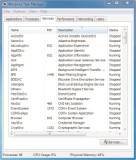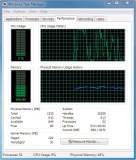What Tabs Found In The Windows Task Manager Dialog Box? (Choose All That Apply).
Windows job director: Viewing Windows 7 processes and applications
If applications or processes in a client's Windows 7 operating system aren't responding, you tin can apply the task managing director to view, end and restart them.
Solutions provider takeaway: You can use the chore manager to view Windows vii applications and processes, and you can also end and restart them if they're unresponsive. The task manager has six tabs in all, including the performance tab that displays usage graphs.
Task Manager
Task Managing director, for many of us, is our "go-to" tool for solving issues. You lot have a trouble, y'all go to Task Director—it's nigh ingrained in us. You'll run into firsthand information about your processes, CPU usage, memory, network, and and so forth.
For ane matter, the first time you start Task Manager, yous'll notice that you lot can now choose to see processes from all the users of the organisation. Ane thing you'll detect right away is the Clarification aspect to the Processes tab and the Services tab (see Figure 11.8). This was added in Vista.
I of the new features of Task Manager is the ability to create a mini-dump file of an awarding that is running. You can correct-click an application or process that is running and choose Create Dump File, which displays a dialog box that shows you lot where that file has been written. You can utilise this feature to discover why a item awarding might be crashing so often. Or if a procedure has already crashed and is no longer responding, you can try to discover the cause.

Figure eleven.8 Task Manager showing the descriptions and options for Services.
Task Manager has six tabs:
- Applications
- Processes
- Services
- Performance
- Networking
- Users
In add-on to the tabs, in that location is a menu at the top that serves upward even more options that we'll as well cover in the following section. Let's get-go by looking at the Applications tab.
Applications
This is the starting point for Windows Chore Managing director and there is more here than meets the eye. The Task column displays a list of open up applications. This is a live look at your system. If y'all close one of the applications, it removes itself from this list.
The Status column shows whether the application is Running or Not Responding. This simple layout allows you to chop-chop see what application is interim up. At the lesser are three buttons:
- End Task: Closes an application or process.
- Switch To: Switches between applications or processes.
- New Task: Starts an application from the dialog box that opens when you click this button.
Below these buttons are real-time data regarding Processes, CPU Usage, and the corporeality of used Physical Memory. At a glance, you can encounter what resources is affected by this view in the Task Manager.
Using Task Manager to End an Application
The following steps evidence you how to use Task Director to end an application.
- Press Ctrl+Alt+Del.
- Click Beginning Task Managing director.
- In the Task area, locate an application that is running and click it.
- Click the End Task push button.
With this simple process, you see how easy it is to close an application. Of class, the purpose of Task Director is to assist you troubleshoot and cope with crashed applications, non ones that are working fine. So the next time an awarding hangs likewise long, follow the above steps once more. When an application hangs besides long, the Status cavalcade shows Non Responding. Clicking End Task should close the awarding.
On rare occasion, an application might stubbornly stay open despite your attempts to end it. In this situation, press Ctrl+Alt+Del again and echo the steps to close it.
Using Task Manager to Start an Application
The post-obit steps show you lot how to use Task Managing director to start an application. In this case, you lot learn to stop explorer.exe and restart it through Task Manager.
- Press Ctrl+Alt+Del.
- Click Showtime Task Director.
- Click the Processes tab.
- In the Image Proper noun column, locate explorer.exe.
- Click the Cease Process push. Windows Explorer closes merely all other applications, including Task Managing director, remain open up.
- Click the Applications tab.
- Click the New Task button. The Create New Task dialog box opens.
- In the Open up text box, type explorer.
- Click OK. Windows Explorer opens.
The Create New Chore button comes in handy in situations that call for you to reopen an awarding. If you know the path to the application, yous tin enter it; otherwise, you can click the Browse button to navigate to the awarding name.
I other option to mention on the Applications tab appears when you right-click any application. You volition discover Create Dump File. Dump files capture information from the application that you tin can share with software developers and programmers who are trying to make up one's mind why an application crashes or has other faults. The dump file is saved locally and is a copy of what the application looks like in memory. Y'all can send it to your help and support department, which can analyze its contents.
Processes
This tab gives you a bird's-heart view of all your processes, including a push to Show Processes from all Users and the aforementioned End Process button. The Procedure tab is invaluable if your calculator is running boring for an undetermined reason. Past viewing the Image Proper name, CPU, Retentiveness, and Description columns, you lot can focus on the precise area causing trouble.
Using Job Director to Monitor an Application's CPU and Retention Usage
The following steps show you how to monitor an application'due south CPU and memory usage. In this example, you monitor Windows Media Player.
- Printing Ctrl+Alt+Del.
- Click Get-go Task Manager.
- Click the Processes tab.
- While still keeping the Task Manager in view on-screen, open up Windows Media Role player. As the application opens, watch the CPU and Memory columns for the information it displays for Windows Media Player. (You lot may need to resize the column to run across the heading names.)
- Close Windows Media Player.
- Open other applications and monitor their resource usage through the processes tab.
By viewing your process resource usage, it becomes evident very quickly which process is causing the problem. If you are looking for a specific procedure and you take several open, click Image Name to sort the column.
If a process is causing trouble, information technology can be stopped by using the Processes tab—every bit you learn in the following section.
Using Job Managing director to End a Process
This short practise teaches you how to end a process through Task Manager. Use caution when doing this on applications not discussed in this exercise. Not ending a procedure safely can upshot in data loss or in rare cases, system instability.
- Press Ctrl+Alt+Del.
- Click Showtime Task Managing director.
- Click the Processes tab.
- Look at the Clarification column and select a procedure that you know (for example, select Windows Chore Manager).
- Click the End Procedure push. You are asked to ostend this.
- Click End Process again. The process ends.
A quick manner to notice a process associated with an application is to first locate the app on the Applications tab, correct-click it, and then choose Become To Process. This takes you to the Processes tab with the associated process highlighted.
If more i user is logged-on to your auto when you run Chore Manager and you are unable to see the procedure you are looking for, the Processes tab includes a Evidence Processes From All Users push that you can click to run into any processes in apply past other users logged on.
Y'all can also right-click an awarding and choose Properties to access the properties of that particular executable. For example, y'all tin can change compatibility options, permissions, as well every bit other aspects of the program.
Services
This tab shows you your services, some descriptive information regarding them (Description and Group information), and if they are running or not. Yous can use this tab to finish or start services.
Using Chore Manager to Stop and Restart a Service
The following steps prove you lot how to cease and restart a service through Task Manager.
- Press Ctrl+Alt+Del.
- Click Start Task Manager.
- Click the Services tab.
- In the Description column, scroll down to Print Spooler, right-click it, and choose Terminate Service.
- Depending on your security configuration, you might receive an admission-denied message. If this is the case, click Impress Spooler again.
- Click the Services button in the lower right.
- If a UAC window opens, click Yes.
- In the master pane, scroll downwardly to Impress Spooler, right-click information technology, and cull Stop.
- To restart the service, follow these same steps, but when you right-click Impress Spooler, and choose Start instead.
Operation
This tab includes a feature that is new to Windows 7 (although you might not notice it). Nether Physical Memory (MB) group, Vista features Full, Cached, and Free. Windows vii has added Available to that group.
- Full: The amount of RAM installed on the arrangement in MB.
- Cached: The corporeality of physical RAM used for organization resources.
- Available: The total of standby and free memory for programs.
- Free: The amount of retentiveness that is currently unused or doesn't contain useful information.
The Performance tab too includes the Resource Monitor button. This is a logical location since you might be coming to the Performance tab to troubleshoot a problem. You can usually observe what you are looking for in the CPU and Memory Usage graphs (see Effigy 11.9). If you lot tin't observe it there, click the Resource Monitor button to access a plethora of monitoring tools.

Figure 11.nine Get real-time stats in the Functioning tab.
Networking
The Networking tab shows a graph of your active network connection, where you can view the network utilization of your connections. The bottom of this tab also includes columns showing the Link Speed and the connection State.
Users
This tab shows you the users who are logged on at present. Past correct-clicking a user, y'all can Disconnect a user who is remotely continued to your computer or Log Off a local user.
Using Job Manager to Log-Off a Local User
The post-obit steps prove y'all how to log-off a local user through Task Director. To complete this exercise, you will need multiple users logged-on at once.
- Press Ctrl+Alt+Del.
- Click Start Task Managing director.
- Click the Users tab.
- Right-click the User you would similar to log off and choose Log Off.
- A alarm message appears, asking you to ostend that yous desire to log off this user (because the user's unsaved information might be lost). Click Log Off User and the user is logged off.
Bill of fare Items
At that place are a few notable selections available on the Task Manager carte du jour:
- On the File menu, y'all can select New Chore to open a program (just as yous can by using the Applications tab).
- On the View menu, you can arrange the refresh speed of the monitoring of your incoming resource. To see faster refreshes on your incoming data for CPU and Retentiveness, go to View, click Update Speed, and and so choose High.
![]()
![]() Managing and Monitoring Windows 7
Managing and Monitoring Windows 7
![]() Using the reliability and resources monitor in Windows 7
Using the reliability and resources monitor in Windows 7
![]() Using Windows 7 performance monitor to view information
Using Windows 7 performance monitor to view information
![]() Windows chore manager: Viewing Windows 7 processes and applications
Windows chore manager: Viewing Windows 7 processes and applications
![]() Using organization backdrop to configure Windows 7 options
Using organization backdrop to configure Windows 7 options
Printed with permission from Que Publishing. Copyright 2010. Using Microsoft Windows 7 past J. Peter Bruzzese. For more information almost this title and other like books, please visit http://www.quepublishing.com.
Dig Deeper on MSP technology services
-

Build a Windows Server 2019 file server cluster for stability
-

11 tips to improve Windows x performance
-

A step-by-step tutorial on how to delete a GitHub repository
-

Create your kickoff RPA robot in UiPath Orchestrator
What Tabs Found In The Windows Task Manager Dialog Box? (Choose All That Apply).,
Source: https://www.techtarget.com/searchitchannel/feature/Windows-task-manager-Viewing-Windows-7-processes-and-applications
Posted by: connorsseent1983.blogspot.com





0 Response to "What Tabs Found In The Windows Task Manager Dialog Box? (Choose All That Apply)."
Post a Comment